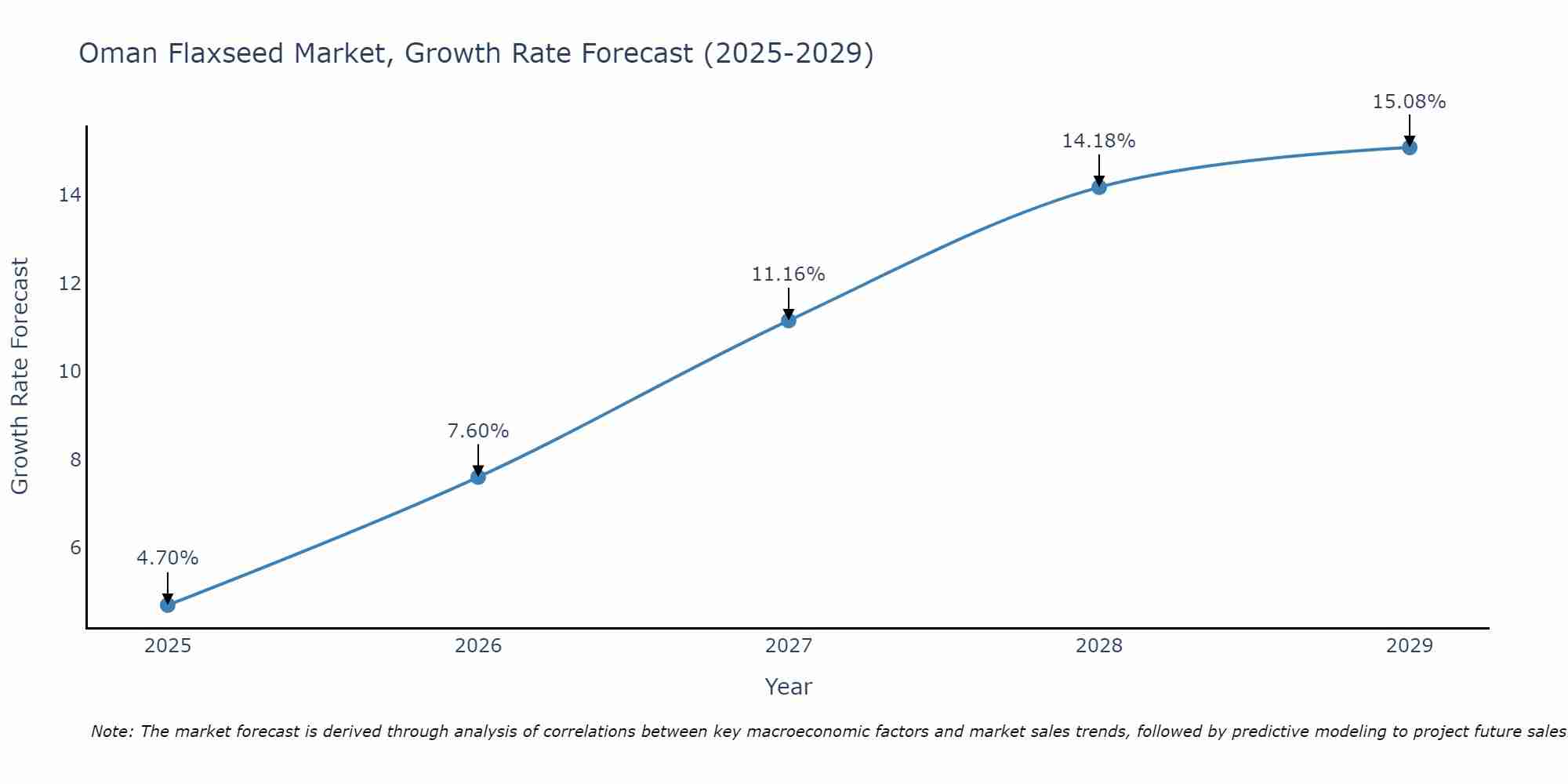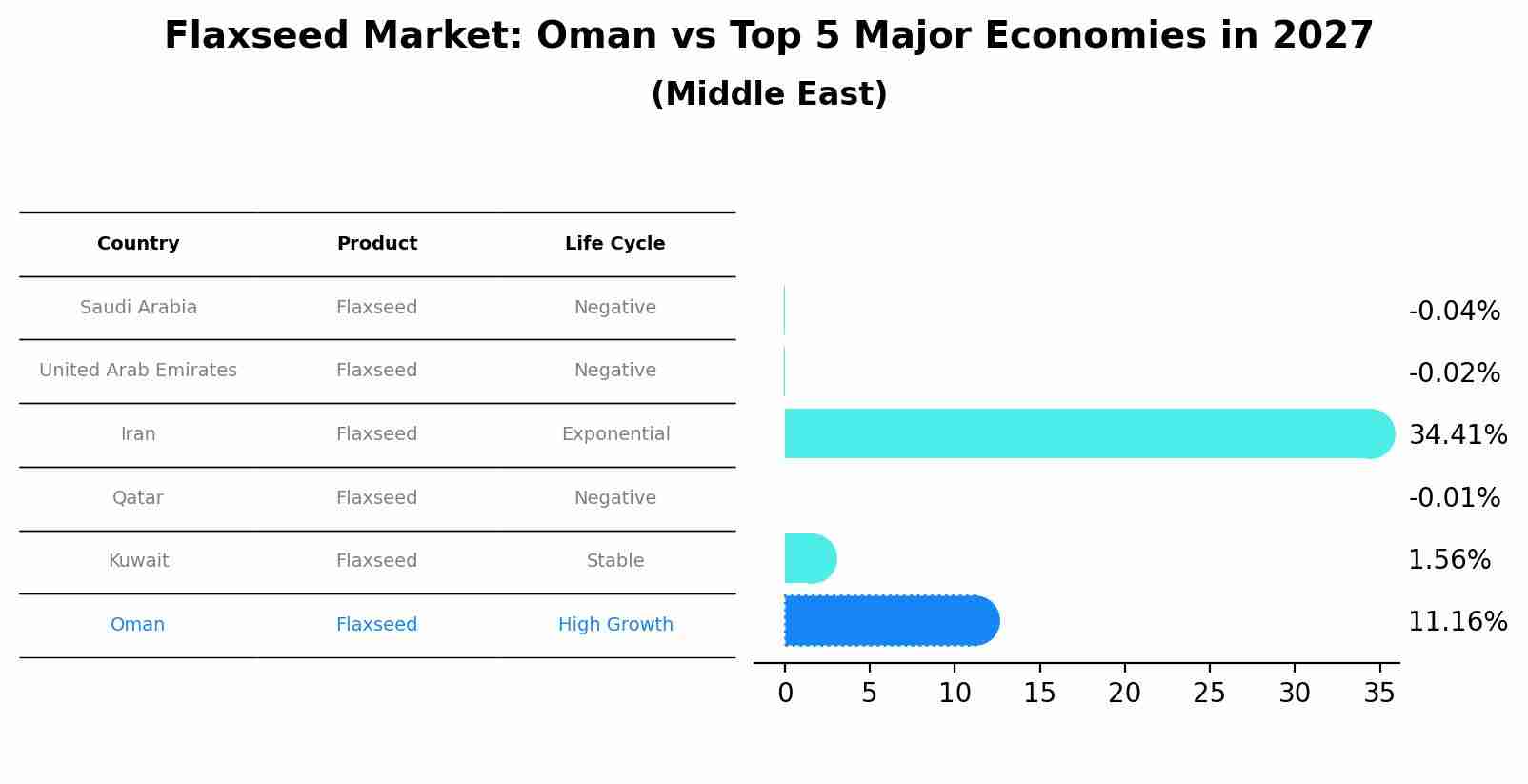Oman Flaxseed Market Outlook | Trends, Value, Industry, COVID-19 IMPACT, Growth, Share, Revenue, Size, Forecast, Companies & Analysis
| Product Code: ETC088922 | Publication Date: Jun 2021 | Updated Date: Jun 2025 | Product Type: Report | |
| Publisher: 6Wresearch | Author: Bhawna Singh | No. of Pages: 70 | No. of Figures: 35 | No. of Tables: 5 |
Oman Flaxseed Market Size Growth Rate
The Oman Flaxseed Market is likely to experience consistent growth rate gains over the period 2025 to 2029. The growth rate starts at 4.70% in 2025 and reaches 15.08% by 2029.

Flaxseed Market: Oman vs Top 5 Major Economies in 2027 (Middle East)
In the Middle East region, the Flaxseed market in Oman is projected to expand at a high growth rate of 11.16% by 2027. The largest economy is Saudi Arabia, followed by United Arab Emirates, Iran, Qatar and Kuwait.

Oman Flaxseed Market Overview
The Oman flaxseed market is experiencing steady growth driven by increasing consumer awareness of the health benefits associated with flaxseeds, such as high omega-3 fatty acids and fiber content. The market is diversified, with key players offering flaxseed products in various forms, including whole seeds, ground flaxseeds, and flaxseed oil. The demand for flaxseeds is also supported by the growing trend of incorporating plant-based sources of nutrition in the diet. Additionally, the market is witnessing a surge in the adoption of flaxseeds by the food and beverage industry for the development of functional food products. As consumers in Oman become more health-conscious and seek natural, nutrient-dense foods, the flaxseed market is poised for further expansion in the coming years.
Oman Flaxseed Market Trends
The Oman flaxseed market is experiencing a growing demand due to the increasing awareness of its health benefits among consumers. Flaxseeds are rich in omega-3 fatty acids, fiber, and antioxidants, making them popular as a superfood for promoting heart health, aiding digestion, and supporting weight management. The market is also witnessing a surge in demand for flaxseed oil and flaxseed-based products like snacks, beverages, and supplements. Additionally, the trend towards natural and organic products is driving the preference for flaxseeds as a natural source of nutrients. With the rising focus on health and wellness, the Oman flaxseed market is expected to continue its growth trajectory as consumers seek out functional foods that offer both nutritional value and health benefits.
Oman Flaxseed Market Challenges
In the Oman Flaxseed Market, some key challenges include limited awareness among consumers about the health benefits of flaxseed, leading to low demand; inconsistent quality of flaxseed products available in the market, impacting consumer trust and product credibility; lack of standardized regulations and quality control measures in the industry, resulting in variations in product quality and safety; and limited availability of flaxseed products in mainstream retail outlets, hindering market penetration. Additionally, the perishable nature of flaxseed products poses challenges in terms of storage and distribution logistics. Overcoming these challenges will require concerted efforts from stakeholders in the industry to educate consumers, improve product quality standards, establish regulatory frameworks, and enhance distribution networks to foster growth and competitiveness in the Oman Flaxseed Market.
Oman Flaxseed Market Investment Opportunities
The Oman flaxseed market presents several promising investment opportunities due to the increasing consumer awareness of the health benefits associated with flaxseeds. With a growing focus on health and wellness in Oman, there is a rising demand for natural and nutritious food products like flaxseeds, which are rich in omega-3 fatty acids, fiber, and antioxidants. Investors can consider opportunities in flaxseed farming, processing, and distribution to capitalize on this trend. Additionally, the potential for value-added products such as flaxseed oil, flour, and supplements further enhances the market potential. Collaborating with local farmers, investing in modern processing technologies, and establishing strong distribution channels can help investors tap into the growing market for flaxseeds in Oman.
Oman Flaxseed Market Government Policy
Oman does not have specific government policies related to the flaxseed market. However, the government has been promoting agriculture and diversification of crops to enhance food security and reduce dependence on imports. The Ministry of Agriculture and Fisheries Wealth (MAFW) provides support to farmers through various programs and initiatives aimed at improving agricultural productivity and sustainability. Additionally, the government has implemented regulations and standards to ensure food safety and quality in the market. While there may not be specific policies targeting the flaxseed market, the overall agricultural policies and support provided by the government create a conducive environment for the growth and development of the sector, including flaxseed production.
Oman Flaxseed Market Future Outlook
The Oman flaxseed market is poised for steady growth in the coming years due to increasing consumer awareness of the health benefits associated with flaxseeds, such as their high omega-3 fatty acid content and potential role in reducing the risk of chronic diseases. The growing trend towards healthier eating habits and the rising demand for plant-based protein sources are expected to drive the market`s expansion. Additionally, the versatility of flaxseeds in various food applications, including smoothies, salads, baked goods, and plant-based meat alternatives, will further contribute to market growth. As consumers continue to prioritize health and wellness, the Oman flaxseed market is likely to see sustained demand and offer opportunities for product innovations and market expansion.
Key Highlights of the Report:
- Oman Flaxseed Market Outlook
- Market Size of Oman Flaxseed Market, 2021
- Forecast of Oman Flaxseed Market, 2027
- Historical Data and Forecast of Oman Flaxseed Revenues & Volume for the Period 2018 - 2027
- Oman Flaxseed Market Trend Evolution
- Oman Flaxseed Market Drivers and Challenges
- Oman Flaxseed Price Trends
- Oman Flaxseed Porter's Five Forces
- Oman Flaxseed Industry Life Cycle
- Historical Data and Forecast of Oman Flaxseed Market Revenues & Volume By Type for the Period 2018 - 2027
- Historical Data and Forecast of Oman Flaxseed Market Revenues & Volume By Ground Seed for the Period 2018 - 2027
- Historical Data and Forecast of Oman Flaxseed Market Revenues & Volume By Whole Seed for the Period 2018 - 2027
- Historical Data and Forecast of Oman Flaxseed Market Revenues & Volume By Application for the Period 2018 - 2027
- Historical Data and Forecast of Oman Flaxseed Market Revenues & Volume By Food for the Period 2018 - 2027
- Historical Data and Forecast of Oman Flaxseed Market Revenues & Volume By Animal & Pet Food for the Period 2018 - 2027
- Historical Data and Forecast of Oman Flaxseed Market Revenues & Volume By Others for the Period 2018 - 2027
- Oman Flaxseed Import Export Trade Statistics
- Market Opportunity Assessment By Type
- Market Opportunity Assessment By Application
- Oman Flaxseed Top Companies Market Share
- Oman Flaxseed Competitive Benchmarking By Technical and Operational Parameters
- Oman Flaxseed Company Profiles
- Oman Flaxseed Key Strategic Recommendations
Frequently Asked Questions About the Market Study (FAQs):
1 Executive Summary |
2 Introduction |
2.1 Key Highlights of the Report |
2.2 Report Description |
2.3 Market Scope & Segmentation |
2.4 Research Methodology |
2.5 Assumptions |
3 Oman Flaxseed Market Overview |
3.1 Oman Country Macro Economic Indicators |
3.2 Oman Flaxseed Market Revenues & Volume, 2021 & 2027F |
3.3 Oman Flaxseed Market - Industry Life Cycle |
3.4 Oman Flaxseed Market - Porter's Five Forces |
3.5 Oman Flaxseed Market Revenues & Volume Share, By Type, 2021 & 2027F |
3.6 Oman Flaxseed Market Revenues & Volume Share, By Application, 2021 & 2027F |
4 Oman Flaxseed Market Dynamics |
4.1 Impact Analysis |
4.2 Market Drivers |
4.3 Market Restraints |
5 Oman Flaxseed Market Trends |
6 Oman Flaxseed Market, By Types |
6.1 Oman Flaxseed Market, By Type |
6.1.1 Overview and Analysis |
6.1.2 Oman Flaxseed Market Revenues & Volume, By Type, 2018 - 2027F |
6.1.3 Oman Flaxseed Market Revenues & Volume, By Ground Seed, 2018 - 2027F |
6.1.4 Oman Flaxseed Market Revenues & Volume, By Whole Seed, 2018 - 2027F |
6.2 Oman Flaxseed Market, By Application |
6.2.1 Overview and Analysis |
6.2.2 Oman Flaxseed Market Revenues & Volume, By Food, 2018 - 2027F |
6.2.3 Oman Flaxseed Market Revenues & Volume, By Animal & Pet Food, 2018 - 2027F |
6.2.4 Oman Flaxseed Market Revenues & Volume, By Others, 2018 - 2027F |
7 Oman Flaxseed Market Import-Export Trade Statistics |
7.1 Oman Flaxseed Market Export to Major Countries |
7.2 Oman Flaxseed Market Imports from Major Countries |
8 Oman Flaxseed Market Key Performance Indicators |
9 Oman Flaxseed Market - Opportunity Assessment |
9.1 Oman Flaxseed Market Opportunity Assessment, By Type, 2021 & 2027F |
9.2 Oman Flaxseed Market Opportunity Assessment, By Application, 2021 & 2027F |
10 Oman Flaxseed Market - Competitive Landscape |
10.1 Oman Flaxseed Market Revenue Share, By Companies, 2021 |
10.2 Oman Flaxseed Market Competitive Benchmarking, By Operating and Technical Parameters |
11 Company Profiles |
12 Recommendations |
13 Disclaimer |
- Single User License$ 1,995
- Department License$ 2,400
- Site License$ 3,120
- Global License$ 3,795
Search
Related Reports
- Middle East OLED Market (2025-2031) | Outlook, Forecast, Revenue, Growth, Companies, Analysis, Industry, Share, Trends, Value & Size
- Portugal Occupational Health & Safety Services Market (2025-2031) | Strategy, Consumer Insights, Analysis, Investment Trends, Opportunities, Growth, Size, Share, Industry, Revenue, Segments, Value, Segmentation, Supply, Forecast, Restraints, Outlook, Competition, Drivers, Trends, Demand, Pricing Analysis, Competitive, Strategic Insights, Companies, Challenges
- Netherlands Occupational Health and Safety Services Market (2025-2031) | Strategy, Consumer Insights, Analysis, Investment Trends, Opportunities, Growth, Size, Share, Industry, Revenue, Segments, Value, Segmentation, Supply, Forecast, Restraints, Outlook, Competition, Drivers, Trends, Demand, Pricing Analysis, Competitive, Strategic Insights, Companies, Challenges
- Belgium and Luxembourg Facility Management Market (2025-2031) | Strategy, Consumer Insights, Analysis, Investment Trends, Opportunities, Growth, Size, Share, Industry, Revenue, Segments, Value, Segmentation, Supply, Forecast, Restraints, Outlook, Competition, Drivers, Trends, Demand, Pricing Analysis, Competitive, Strategic Insights, Companies, Challenges
- Russia Women Intimate Apparel Market (2025-2031) | Strategy, Consumer Insights, Analysis, Investment Trends, Opportunities, Growth, Size, Share, Industry, Revenue, Segments, Value, Segmentation, Supply, Forecast, Restraints, Outlook, Competition, Drivers, Trends, Demand, Pricing Analysis, Competitive, Strategic Insights, Companies, Challenges
- Africa Chocolate Market (2025-2031) | Size, Share, Trends, Growth, Revenue, Analysis, Forecast, industry & Outlook
- Global Hydroxychloroquine And Chloroquine Market (2025-2031) | Industry, Trends, Size, Outlook, Growth, Value, Companies, Revenue, Analysis, Share, Forecast
- Saudi Arabia Plant Maintenance Market (2025-2031) | Industry, Size, Growth, Revenue, Value, Companies, Forecast, Analysis, Share & Trends
- Taiwan Electric Truck Market (2025-2031) | Outlook, Industry, Revenue, Size, Forecast, Growth, Analysis, Share, Companies, Value & Trends
- South Korea Electric Bus Market (2025-2031) | Outlook, Industry, Companies, Analysis, Size, Revenue, Value, Forecast, Trends, Growth & Share
Industry Events and Analyst Meet
Our Clients
Whitepaper
- Middle East & Africa Commercial Security Market Click here to view more.
- Middle East & Africa Fire Safety Systems & Equipment Market Click here to view more.
- GCC Drone Market Click here to view more.
- Middle East Lighting Fixture Market Click here to view more.
- GCC Physical & Perimeter Security Market Click here to view more.
6WResearch In News
- Doha a strategic location for EV manufacturing hub: IPA Qatar
- Demand for luxury TVs surging in the GCC, says Samsung
- Empowering Growth: The Thriving Journey of Bangladesh’s Cable Industry
- Demand for luxury TVs surging in the GCC, says Samsung
- Video call with a traditional healer? Once unthinkable, it’s now common in South Africa
- Intelligent Buildings To Smooth GCC’s Path To Net Zero













